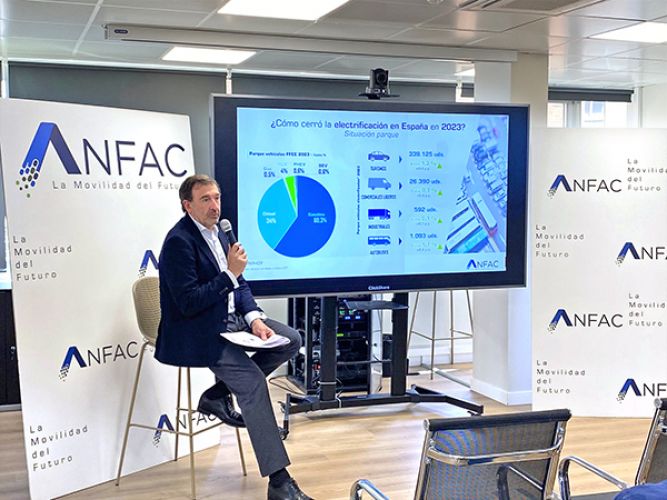
Electrification does not reach the truck
In 2023, 341 heavy electric vehicles were registered in Spain, with a share of 1.2%, while the total fleet reaches 592 units and a share of 0.1%, according to the Anfac Electromobility Barometer.
The presence of electric trucks on Spanish roads continues to be testimonial. This is confirmed by the latest Electromobility Barometer presented yesterday by the vehicle manufacturers’ association Anfac, at a press conference held in Madrid.
“The figures for commercial vehicle registrations are especially striking, which are very low for a sector that represents 4.8 percent of the GDP in our country,” warned the general director of Anfac, José López-Tafall. “It is a sector of extremely high importance and one that faces an enormous challenge such as its decarbonization,” he noted.
Last year, the number of electric heavy trucks registered in Spain amounted to 341 units, which represents a share of 1.2 percent of the total units sold. Most of these vehicles were small or medium-sized trucks, according to López-Tafall.
For its part, the number of electric commercial vehicles sold in our country was somewhat more significant and stood at 9,965 units last year, which represents a percentage of 6.8 percent of the total. However, this type of vehicle has 26,390 operational units in Spain, which represents a share of only 0.7 percent of the total of this segment of the fleet.
In this context, “we are putting a lot of focus on industrial vehicles specifically,” López-Tafall insisted. Anfac has established a roadmap for this type of vehicles that is currently being discussed with the Ministry of Transport and Sustainable Mobility, as reported. “In the short term, it is essential to renew the Moves Plan for commercial vehicles with a sufficient amount, which ends on April 30,” he said.
“The plan must incorporate improvements that we are negotiating with the Ministry,” the manager noted. Among these improvements is contemplating the acquisition of this type of vehicle through renting, “a very common acquisition formula in the transportation sector.” At the same time, “it is necessary to improve conditions and promote charging infrastructure,” he added.
Governance
Anfac also insists that “for the system to work, governance must be put in place.” To this end, the manufacturers’ association proposes taking advantage of the Sustainable Mobility Law to create a state center for the development of public access charging infrastructure (CEIRVEA), which allows tracking, monitoring and promotion.
Precisely, the charging infrastructure is one of the main barriers to the implementation of electric trucks in our country. The report prepared by Anfac establishes that last year 11,173 new charging points were installed, which puts the total number at 29,301.
Despite the fact that “just four years ago there were barely 8,800 charging points,” as López-Tafall recalls, the volume achieved is far from the 45,000 set as a goal for last year if the goals set are to be achieved.
Anfac points out that, “to the number of points, we must add the attribute of quality, that is power, making it necessary to promote the deployment of ultra-fast charging, to reduce the charging times of electrified vehicles.”
Furthermore, “in Spain there are no public access charging points specifically dedicated to heavy vehicles, neither in terms of power nor in terms of accessibility,” the employers denounce. “Electric trucks need high charging power and availability of space to be able to recharge and currently there are hardly any points like that,” López-Tafall lamented.

